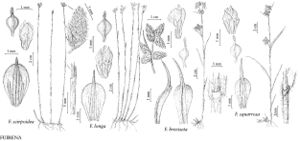Fuirena
Descr. Icon. Rar. Pl., 70. 1773.
Herbs, annual or perennial, cespitose or not, rhizomatous or not, variously pubescent. Culms solitary or not, 3–5-angled in cross-section. Leaves all cauline, polystichous, usually hairy, hair sometimes confined to junction of blade and sheath; sheaths closed, tubular; ligules tubular, scarious; blades sometimes absent or reduced to mucro or cusp, flat, or those mid culm strongly formed. Inflorescences of spikelets sessile in clusters of 2–5 (rarely solitary), the clusters sessile or pedunculate and terminal or racemose; spikelets to 150. Spikelets: scales 20–50, spirally arranged, proximal 1–2 scales empty, others subtending flower, some distal scales empty. Flowers bisexual; perianth (3–) 6 in sets of 3, outer set of stout, sharp bristles shorter than inner set of stipitate-bladed, spatulate scales, rarely inner set forked or pinnately lobed; stamens 1–3 (–6), long-exserted; styles linear, 3-fid, articulate well distal to base, base usually persistent. Achenes trigonous-rhomboid.
Distribution
Worldwide, mostly in subtropics and tropics
Discussion
Species ca. 30 (7 in the flora).
Nearly all species are heliophytic wetland plants.
Rhizomes of the fuirenas are compact to elongate. Culms arise directly from rhizomes or from short, fleshy, cormlike shoot buds; they are cespitose or lined along rhizome, erect to sprawling, grooved or sharply angled, variously ribbed, stiff or flaccid, and smooth except in the inflorescence. Most proximal nodes are usually widely spaced, producing the largest bracteal leaf and longest peduncle. Internodes and bracts are progressively shorter on distal culm. Leaf sheaths are strong and many ribbed; ligule and contraligule are connate to form a short, oblique or truncate, ciliate tube. If midculm leaf blades are formed, they are variously linear, the base cordate-clasping, margins variously thickened or not, and the apex narrowly acute and often hirsute-ciliate. Inflorescences are green, green-brown, or red-brown, mostly sessile, ovoid, ellipsoid, or lance-cylindric, mostly 1–2 cm. Flowers are mostly 2.5–3.5 mm, excluding long-exserted stamens; filaments slender, flattened; anthers erect, 2-locular, oblong-linear; ovary 3-carpellate; styles elongate, filiform, hispidulous. Achenes are usually prominently stipitate, angles wirelike, 1 mm, faces smooth to finely reticulate, apex usually peglike, erect, linear, slightly dilated, stiff, papillose-hispidulous; beak rarely present, short-triangular.
Fuirena wallichiana, an Asian species, has been found in the flora only once, in wet areas of chrome ore piles at Newport News, Warwich County, Virginia, by Clyde F. Reed (PH!). It is cited here as a chance introduction whose continuance in a unique habitat should be monitored. It is included in the key to facilitate identification; it is not included in the species count.
Selected References
None.
Lower Taxa
Key
| 1 | Perianth 3–6-parted, each part pinnately lobed or with flat, linear branches, none with broad blades. | Fuirena wallichiana |
| 2 | Plants not rhizomatous, usually annual; anthers mostly 0.5–0.7(–1.2) mm. | > 3 |
| 2 | Plants rhizomatous, usually perennial; anthers at least 1.3 mm. | > 4 |
| 3 | Apex of perianth blades obtuse to retuse, with abaxial, subapical, retrorsely barbellate bristle; prairie provinces w of Mississippi River. | Fuirena simplex |
| 3 | Apex of perianth blades acuminate, usually very narrowly so, mostly incurved, without abaxial, subapical bristle; Atlantic and Gulf coastal plains with outliers in Lake States. | Fuirena pumila |
| 4 | Culms slender, wandlike, smooth, on elongate, creeping, non-cormose rhizomes; mucro of fertile scales erect, mostly less than 1/2 length of scale body; leaf sheaths either bladeless or with blades rarely to 5 cm; fertile scales usually with at least 5 strong medial ribs. | > 5 |
| 4 | Culms stout, usually with at least some prominent long hairs on leaf margins and/or sheaths, from elongate to short, cormose rhizomes; mucro of fertile scales erect or spreading-recurved, 1/2 or more length of scale body; leaf sheaths with well-developed blades, the longer rarely as short as 5 cm; backs of fertile scales usually with 3 prominent medial ribs. | > 6 |
| 5 | Blades of culm leaves short, mostly mucrolike, rarely more than 4 mm; tip of perianth blades mostly acute; spikelets mostly ovoid, sessile in terminal cluster; subtending involucral bract shorter than spikelets. | Fuirena scirpoidea |
| 5 | Blades of culm leaves long, usually plane, to 5 cm; tip of perianth blades acuminate; spikelets mostly lance-ovoid or lance-cylindric, narrowly acute, sessile in terminal cluster or sometimes producing secondary peduncled spikelets or small secondary clusters; subtending involucral bract longer than spikelets. | Fuirena longa |
| 6 | Rhizomes without cormlike shoot buds; apex of perianth blades flattish or tumid, conic, blunt or emarginate, usually producing short or elongate, sub-apical, abaxial apiculus or bristle. | Fuirena simplex |
| 6 | Rhizomes with cormlike shoot buds; apex of perianth blades obtuse-angled, acute, acuminate, or narrowly incurved-conic, without subapical, abaxial apiculus or bristle. | > 7 |
| 7 | Perianth bristles short, incurved, smooth, tip not reaching base of perianth blades; proximal leaf sheaths hispid, midculm and distal sheaths becoming smooth; apex of perianth blades obtuse-angled or acute, neither conic nor acuminate. | Fuirena breviseta |
| 7 | Perianth bristles long, erect or even slightly spreading, tip reaching at least to base of perianth blades; all leaf sheaths usually hispid, hispidulous, or hirsute; apex of perianth blades either conic and very tumid, or acuminate. | > 8 |
| 8 | Apex of perianth blade acuminate, thin or thickened, incurved; perianth bristles retrorsely barbellate; anthers 1 mm; Gulf and Atlantic coastal plains and inland to adjacent provinces e of Mississippi River, with cormose rhizome buds usually close-set. | Fuirena squarrosa |
| 8 | Apex of perianth blade tumid at maturity, narrowing distally to conic and erect, sometimes apiculate as well; perianth bristles smooth; anthers 1–1.3 mm; Gulf Coastal Plain and Ozarks from Louisiana and Arkansas southwestward, with cormose parts of rhizome often separated by distinct intervals of narrow internode longer than corm width. | Fuirena bushii |
"shortened" is not a number.


